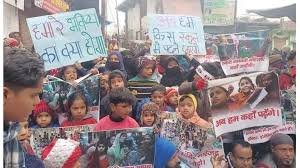Smog and fog prove death knell for north Indian cities

Smog and fog prove death knell for north Indian cities
By Rashme Sehgal
The cities of north India are reeling under a fatal combination of smog and dense fog. The worsening air quality and the lack of sunshine during the past few weeks have left its citizens reeling under the biting cold. And for millions who have no heating devices to fall back upon, living conditions in the Indo-Gangetic belt are close to intolerable.
Delhi leads the pack and has emerged as one of the most polluted cities in the world. But other state capitals including Patna, Lucknow and Jaipur are snapping at its heels showing high AQI levels touching 500 and more which is almost 100 times above what the World Health Organization has deemed healthy. Even DehraDun with its salubrious climate has seen a quantum jump in AQ 1 levels although the city, protected as it is by the Shivalik hills and the middle Himalayas, manages to get some amount of sunshine during this cold, grimy period of the year.
The combination of fog and cold weather does not allow the PM 2.5 and PM 10 particles from rising above the ground level. This happens every year but in the capital city, December 2023, the air quality has been much worse than the last six years. The average AQI level between 2018 to 2022 was around 332 while on December 1, it was 372 and has been climbing steadily since. On December 23, it had reached 450, an extremely concerning figure.
This cold weather smog sees PM 2.5 levels register a dangerous 100 per cent increase, piercing the lungs and precipitating a host of diseases. Delhi has emerged as the world’s most polluted city with an Air Quality Life Index released by the Energy Policy Institute at the University of Chicago showing that Delhi residents are likely to lose 11.9 years of their life if the current levels of pollution persist.
The study also showed that all of India's 1.3 billion people live in areas where the annual average particulate pollution level exceeds the 5 μg/m3 limit set by the World Health Organization. It also found that 67.4 per cent of the country’s population lives in areas that exceed the country’s own national air quality standard of 40 μg/m3. The implication of this is that these PM2.5 pollution levels are expected to shorten an average Indian’s life expectancy by 5.3 years.
Deaths attributed to air pollution range from strokes, diabetes, lung cancer and myocardial infarctions. Poor air quality has a drastic effect on the human respiratory system because the small PM 2.5 particulates travel deep into the lung tissue from where they pass through body tissue and can even enter the heart.
Reduced lung capacity, sore throats, coughs, fatigue, headaches and lung cancer are all typical symptoms that doctors warn show a sharp rise during this time of the year.
Sadly, while earlier our mofussil towns were protected from air pollution this is no longer the case. The Central Pollution Control Board that monitors air pollution has found that the stifling haze that covers our cities affects not just Noida and Ghaziabad, Aligarh, Varanasi and Patna but mofussil cities in Bihar, West Bengal, Maharashtra and Madhya Pradesh. Even coastal cities such as Mumbai saw citizens complain of burning eyes, choking and troubled breathing in October 2023.
The BJP has been putting the blame of poor air quality in the NCR region on the stubble burning started in October by the farmers of the Punjab insisting the AAP had failed to provide proper alternatives to the farmers. AAP party spokesperson on the other hand claimed that while there had been 81,000 farm fires in Punjab in 2016, there were only 19,000 in 2023.
This figure was contradicted by NASA statistics which claimed there were many more fires than the figure put out by AAP. AAP countered this by blaming the UP and Punjab state governments for its failure to provide an uninterrupted electricity supply forcing industry and housing societies to use polluting diesel generators.
To get to the root of this problem, we need to understand that one of the main sources of pollution has been the unrestricted increase in personal cars and two – wheelers across India. Delhi alone registered 1.2 crore vehicles in 2020. While the Ministry of Environment takes pride in tom-toming how vehicles registered in Delhi are using BS 4 petrol and diesel, cities outside Delhi continue to use the more polluting BS 3.
The number of vehicles plying in Delhi on any day exceeds the registered vehicles figure because of cabs from neighbouring cities and the trucks and buses bringing in essential commodities to the city use poorer quality petrol and diesel.
The government also needs to remember that air cannot be restricted to just one city as pollutants from one city are going to spread their tentacles across other regions.
The other major problem is the lack of environmental accountability enjoyed by construction and infrastructure companies who are allowed to break every norm in the book.
Finger pointing serves little purpose. Even as winter draws to an end, pollution levels across our cities will not come down. The weary citizens, especially the elderly and young, want the central and state governments to sit together and draw up a national plan as also a city specific plan so that PM 2.5 levels are immediately reduced by over 60 to 80 per cent in order to meet the National Ambient Air Quality standards set by the Ministry of Environment.
Delhi has set up a Commission for Air Quality Management (CAQM), a statutory body responsible for strategies to combat pollution. It has prepared a graded response plan, and when Grade 4 response kicks in, the CAQM will ban diesel BS- 4 and all BS-3 private cars and also ban diesel-run medium and heavy goods vehicles in the city. When pollution levels rise, schools are closed and a ban on construction activities is imposed.
But these are short term measure. The root of the problem requires the enforcement of strict laws that to start with will impose restrictions on the use of private vehicles. This of course means a transition from private vehicles to the use of public transport but only when this is done will it show the government means business.
The seriousness of this matter continues to be lost on our decision-makers. A few years ago, Dr Arvind Kumar, who headed the Lung Care Foundation at Sir Ganga Ram Hospital, recreated a pair of large human lungs with the help of High- efficiency Particulate Air filters, which are used to trap dust in operation theatres.
These “lungs’ were designed to mimic the workings of a pair of human lungs. Dr Kumar had expected the lungs to become dark (signifying high pollution) over time, but they started to darken in just one day and went utterly dark within six days. Speaking about the effects of pollution in the capital and in fact the entire country Dr Kumar said, “There are no non-smokers left in India. We have become a nation of smokers.”
It is simply not enough to shiver and bear the cold. This alarming situation needs to be countered by decisive and drastic measures at the political level. The public also needs to ensure that environment becomes a key issue in our coming Lok Sabha elections. The bell is tolling for all of us. There is no time to waste.
(Rashme Sehgal is a senior independent journalist.)






